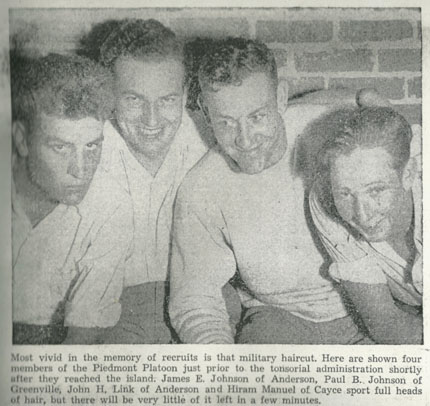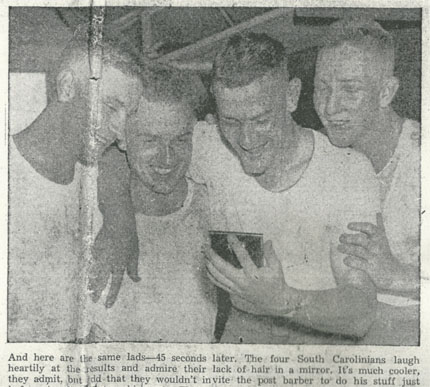Connecting to and Crafting the Past

My grandfather, John H. “Harry” Link (third from the left), just before getting his Marine haircut in 1942. Image from the Anderson Independent.
For a good while now, I have been fascinated with researching my family history. I think it all started with a project in the eighth grade, but it’s been ongoing ever since. I would guess that a reason that dabbling in geneaology is such a popular past time among Americans is because our history here is so new, at only a few hundred years old—wait, but what about the Native Americans?—that’s a sad story for another day. Nevertheless, odds are, the ancestors of most Americans came here in order to start new, perhaps even to forget their past in search of better opportunities. In the fast-paced contemporary world, we often find time to question where we’ve come from and want to find a connection with the past. We remember the past not only by thinking about specific events in our own lives, but we also “remember” where our families have come from by thinking of old stories and recounting old photos and relics left behind by those who’ve left us. I might not have actually witnessed in person what my grandparents went through in the 1940s, but I still “remember” what happened through old photos and stories. In a way, this archive of imagery stored in our minds helps us craft memories of our past. Add to that the power of the internet and the ability to fill in the names of whole branches of your family tree with a few clicks, and we begin to form a notion of the past of which we might not have even conceived before.
So how much does all this relate to contemporary visual culture in terms of art and design? A great deal. The idea of crafting a sense of the past is something I find really interesting and I hope to make this a loose ongoing theme for the blog in the next few entries. I hope you’ll join me as I take a look at a few interesting examples, including: the modern-day version of a court painter in Saudi Arabia whose role is to help legitimize the rule of monarchy by making monumental artwork, the use of heraldry/crests/shields in modern brand identities, and the role that museums play in creating the past. This should hopefully be fascinating and revealing.

After the haircut. I love these captions! This one looks like it suffered from the shears of my grandmother.